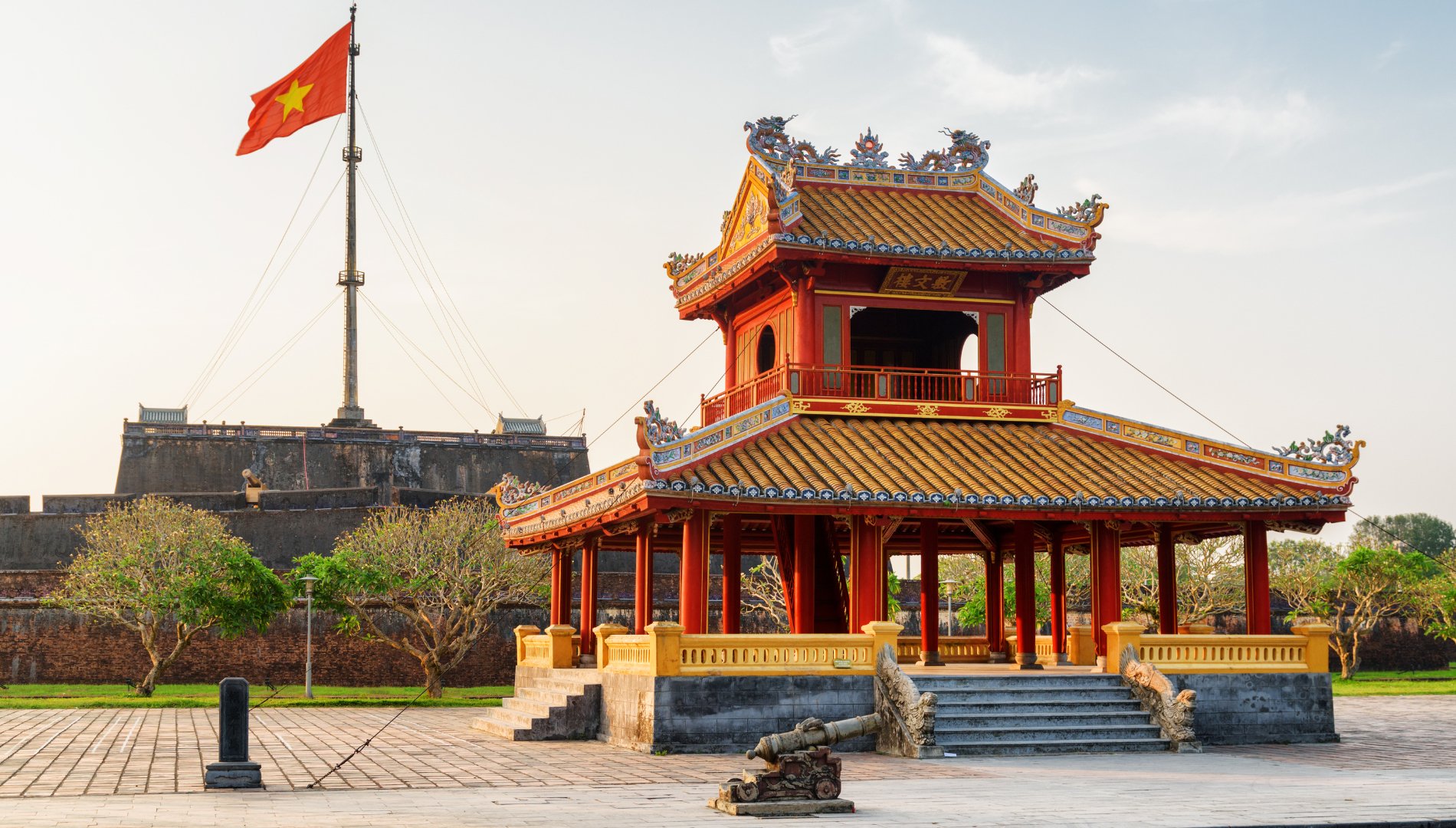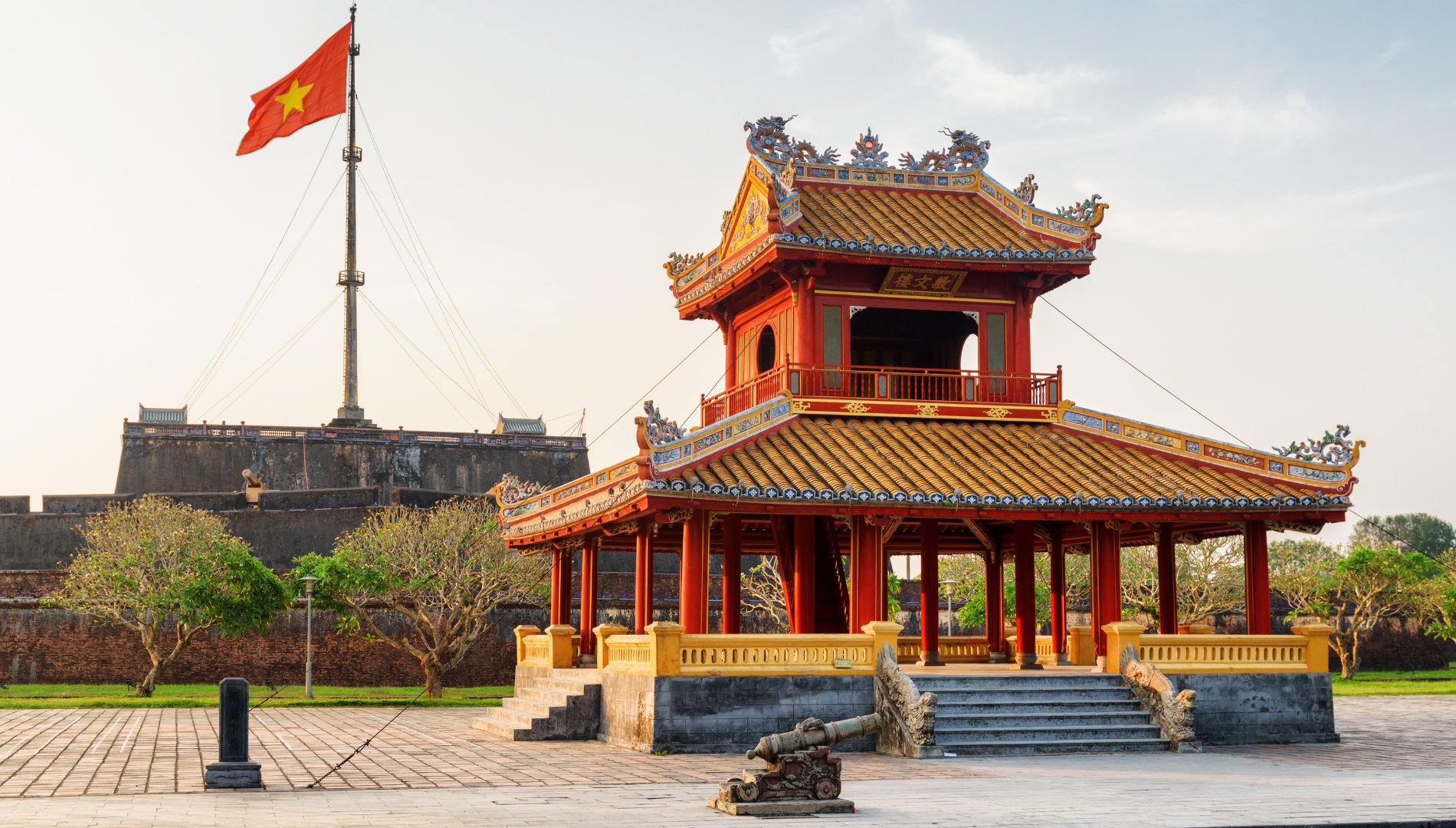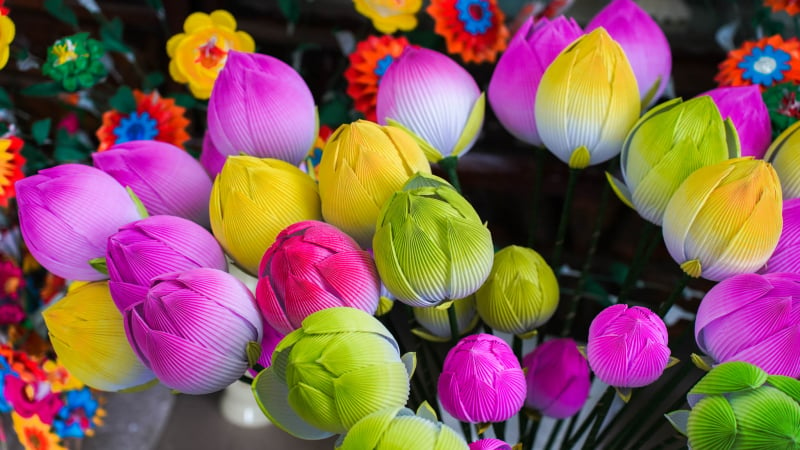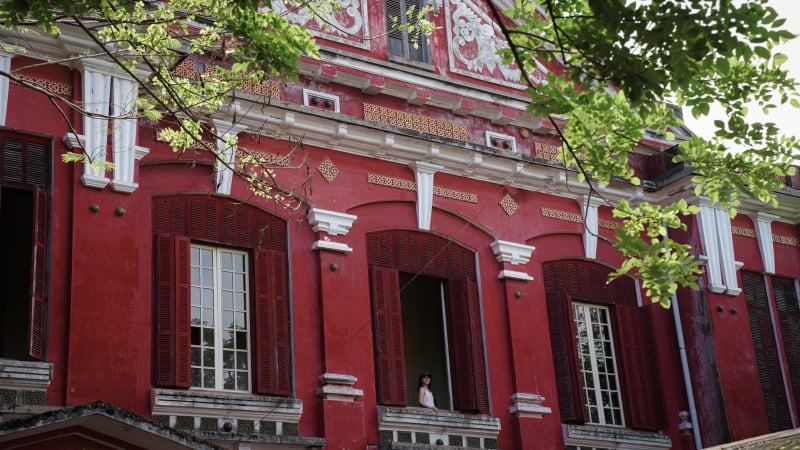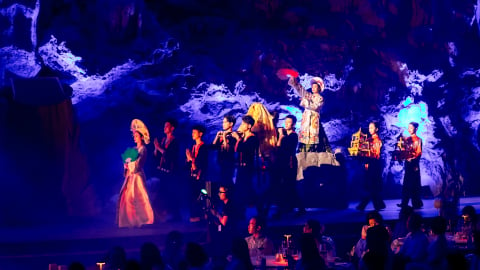“Every afternoon in front of Van Lau wharf,
Who sits, who fishes, who is sad, who is miserable?
Who loves, who feels, who remembers, who looks?
Whose boat is looming by the river?
Hearing the song "The Rooster Pushes the River", my heart aches for the country and mountains!
Along the poetic Huong River, in the heart of the ancient capital of Hue, there is a small architectural work but it carries within itself a rich history and profound cultural value, Phu Van Lau. Located majestically right next to the river bank, in front of the Flag Tower and behind Nghenh Luong Dinh, Phu Van Lau is not only a silent witness to the ups and downs of the Nguyen Dynasty but also a proud symbol of Hue, proudly appearing on the 50,000 VND banknote of Vietnam.
Phu Van Lau is located in a prime location, right outside the facade of the ancient Phu Xuan citadel, now in Phu Hoa ward, Hue city. With a distance of only 700m from the Imperial City and opposite Ngo Mon Gate of Hue, this construction is not only easy to access but also has strategic significance in the capital's architectural system. The name "Phu Van Lau" is interpreted from three Chinese characters: "Phu" (display), "Van" (documents), and "Lau" (high floor), implying "a place for announcing and displaying documents of the Nguyen Dynasty court".
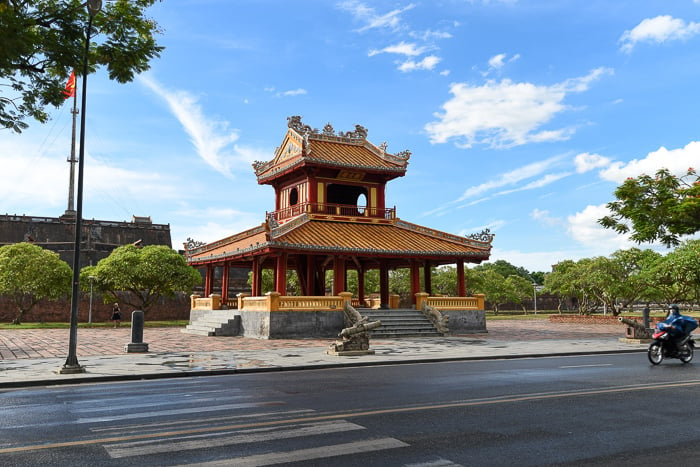
Phu Van Lau - the pearl in front of Hue citadel
Historically, Phu Van Lau originated from a small communal house named Bang Dinh, built under King Gia Long to post the results of the Hoi and Dinh examinations. In 1819, under King Minh Mang, Bang Dinh was officially renovated and upgraded to a more spacious Phu Van Lau, becoming the place to announce important royal edicts. Since 1821, after the ceremony of passing the exam, the list of successful doctors was also solemnly posted here. The majesty of Phu Van Lau is also shown through the stone stele "Khuynh cai ha ma" erected on the roadside, reminding people passing by to "tipped their hats and dismounted" to show respect to the royal court. Through many events and many restorations, Phu Van Lau still retains the typical architectural features of the Nguyen Dynasty, affirming the sustainability of a heritage.
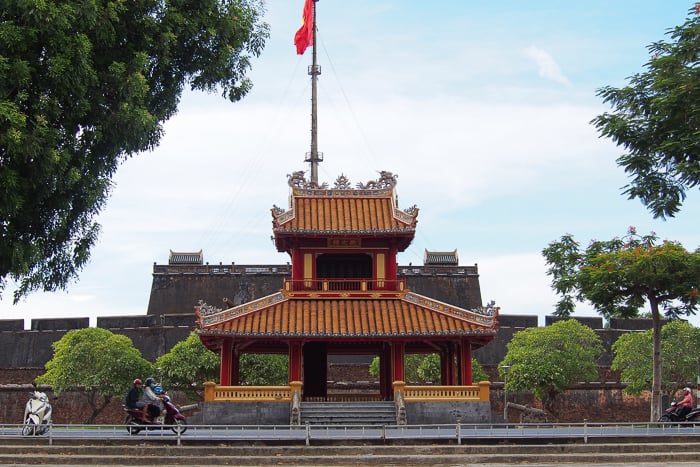
Phu Van Lau is an architectural work with the most important position and role in the complex of Hue ancient capital relics. Phu Van Lau is located in front of Ky Dai - outside the citadel, on the sacred axis of the citadel and the imperial citadel.
The architecture of Phu Van Lau is a living testament to the talent of ancient craftsmen. This two-story building was built entirely of rare ironwood, with a sturdy column system and sophisticated carvings. The roof is covered with golden glazed tiles, which shine like gold under the sunlight, creating a splendid and majestic beauty. The ground floor of Phu Van Lau is designed to be completely open, with a 65cm high railing painted with a light yellow lime layer. This is where the royal decrees, edicts and examination results are placed on the dragon pavilion with a canopy, after being read at Thai Hoa Palace or Ngo Mon Gate, for soldiers to bring out and post.

Phu Van Lau is a two-story wooden building with 16 columns, of which the four middle columns are two stories high; including eight roofs divided into two layers, covered with glazed tiles.
On the upper floor, all four sides of the building are built with wooden planks, with square windows on the front and round windows on the two sides, symbolizing the concept of yin and yang harmony. Around the outside is a system of wooden railings, delicately crafted with floral, dragon and phoenix motifs, imbued with the style of royal art. The four sides of the second floor are designed in the style of "silk frame", that is, the wooden bars are interwoven to form squares and rectangles, reminiscent of soft silk paintings. On the front windows, the gilded red-lacquered horizontal lacquered boards decorated with stylized "two dragons facing the moon" leaves further enhance the majesty of the building. In addition, in the front yard of Phu Van Lau, the royal court also arranged two small bronze cannons, located on both sides of the building facing the center, like silent sentries.
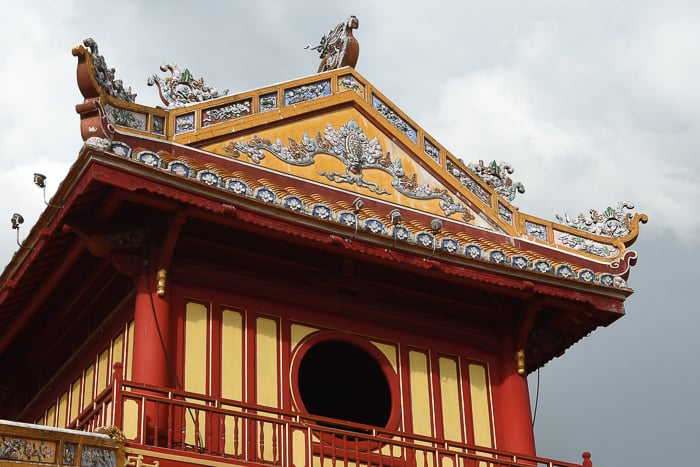
The upper floor rests on four central columns and is walled in wood with windows at the front and sides; there is a wooden railing all around.
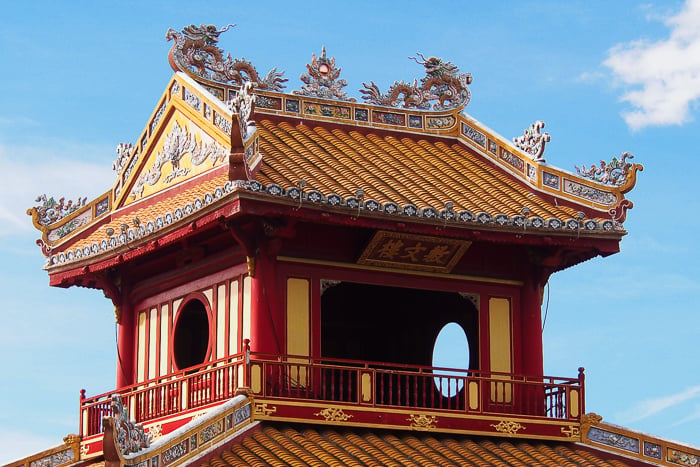
On the first floor, in front, under the roof and above the window, there is a horizontal plaque with three words "Phu Van Lau"

The ridges and roof edges are elaborately decorated with dragon and flower motifs in the style of porcelain mosaic.
Not only a place to publish documents, Phu Van Lau is also associated with many important anecdotes and events of the royal court. Most notably, in 1826, this was the place where the elephant and tiger fight was held for King Minh Mang to watch. On important occasions such as the king's 40th and 50th birthdays, many grand celebrations were also held here. Later, King Tu Duc and King Thieu Tri also maintained this tradition on the occasion of their birthdays. In particular, King Thieu Tri also considered Phu Van Lau on the Huong River as one of the 20 famous beautiful scenes of Hue citadel, proving the beauty and special position of this work in the hearts of the people and the kings.
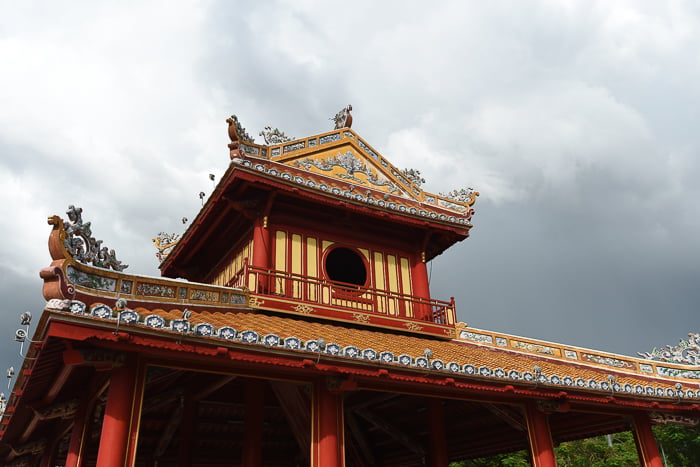
Although it is a small structure, Phu Van Lau is a work of high aesthetic and artistic value, in harmony with the landscape, and is a highlight of the space in front of the citadel.
Along with Phu Van Lau, Nghenh Luong Dinh is also an ancient architectural work, gilded with gold, contributing to the charming beauty of the Huong River bank area. Formerly known as Luong Ta, located in the Huong Giang palace, Nghenh Luong Dinh was built in the form of a four-room house, with two crab-shell houses extending in the front and back. The wooden frames are elaborately carved, the main house's roof is covered with golden glazed tiles, and the two crab-shell houses are covered with golden glazed tiles, with the roof inlaid with phoenix and dragon-shaped ceramics. The communal house's floor is 90cm high, paved with bricks and stone, on the river bank there are 13 steps leading down to a corridor built close to the water, creating favorable conditions for Nguyen Dynasty kings to enjoy the cool breeze and take a boat trip on the Huong River. With an airy, lyrical landscape, Nghenh Luong Dinh is an ideal place to admire the romantic beauty of the Huong River at dawn, dusk or on a moonlit night.
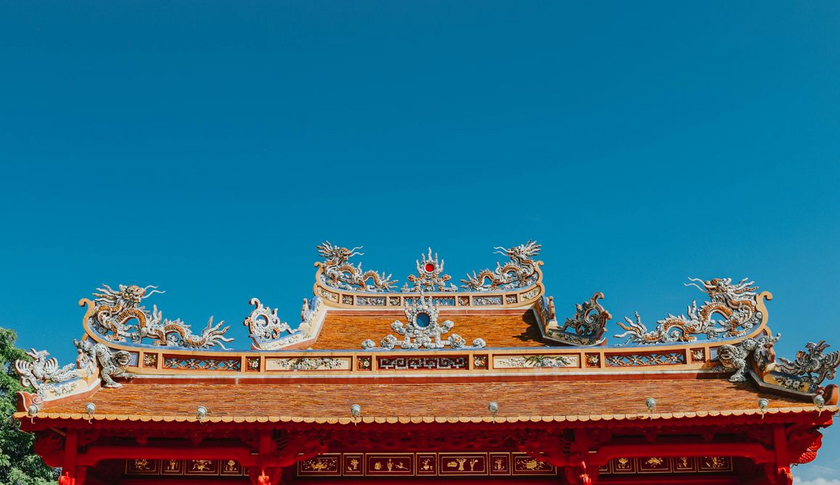
Nghinh Luong Dinh relic - Ancient architecture in the heart of Hue city
Today, Phu Van Lau and Nghenh Luong Dinh are not only important historical relics but also attractive destinations for domestic and foreign tourists. Images of these two structures are printed on the 50,000 VND polymer banknote of Vietnam, demonstrating their historical and cultural values and timeless architectural beauty. When visiting, visitors seem to go back in time, to the golden years of the Nguyen Dynasty. Take the time to carefully read the information boards, observe the images and artifacts to discover their interesting history, from the humble Bang Dinh in the beginning to the majestic buildings of today.
To have a complete and meaningful trip, visitors should remember to wear polite, discreet clothes, wear comfortable shoes for easy movement. At the same time, keep public hygiene, do not climb or carve on relics, take polite photos and maintain public order. Bringing hats, caps, and sunscreen is also very useful when visiting in the sun. Phu Van Lau and Nghenh Luong Dinh are not only outstanding architectural works but also places that preserve the sacred soul of Hue's history and culture. Standing among the gilded lim columns, listening to the rhythm of life by the Huong River, each visitor will feel the peace and depth of the ancient capital, carrying in their hearts unforgettable memories, a journey connecting the past and present.





